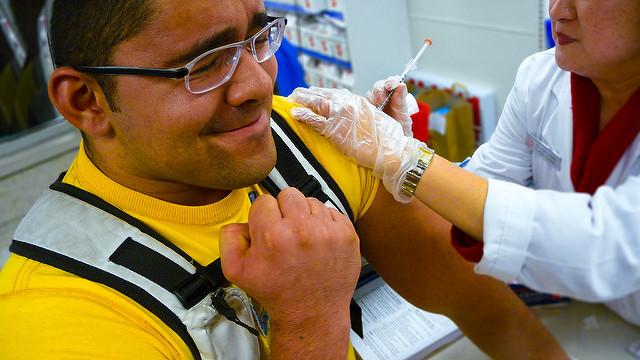In an annual push to build awareness and support for seasonal flu vaccination today, US health officials said they hoped the absence of the inhaled flu vaccine doesn't erode steadily rising immunization rates in kids and noted rising uptake in healthcare personnel, especially those working in long-term care settings.
Experts, including Centers for Disease Control and Prevention (CDC) Director Tom Frieden, MD, MPH, spoke at a media briefing hosted by the National Foundation for Infectious Diseases (NFID). Now in its 20th year, the NFID event typically sketches out the lay of the land with flu vaccine developments and officials' views of how upcoming flu season could unfold.
Frieden said flu vaccines aren't perfect, but can cut the risk of flu by at least half, far better than any other method for preventing the disease. Among sobering statistics about flu, he said 90% of children who die from their infections weren't vaccinated and in a bad year the virus can kill 49,000 Americans.
He said about 144 million Americans were vaccinated last year, with an overall uptake of about 46%, a slight decline from the previous year. The CDC has seen some softening in the numbers of vaccinated seniors, typically a group that has high uptake. Frieden said it's unclear if a vaccine poorly matched to one of the circulating strains during the 2014-15 flu season had an impact on immunization last season.
Vaccine developments, flu activity
Flu vaccine makers expect to produce 157 million to 168 million doses for the US market, and 93 million doses have already been distributed, Frieden said. Over the summer, the CDC's vaccine advisors, the Advisory Committee for Immunization Practices (ACIP), recommended against the live attenuated influenza vaccine (LAIV) after CDC vaccine effectiveness studies found no protection in children, a finding that puzzlingly hasn't been replicated in other countries.
Though a few local flu clusters have been reported to the CDC, it's too soon to predict how the season will develop and whether the vaccine strains are a good match with circulating strains. Frieden said so far, the vaccine appears to be a good match with the flu strains that circulated in the United States at the end of the last flu season.
When asked about a World Health Organization (WHO) panel's pick of a different 2009 H1N1 strain for the 2017 Southern Hemisphere flu season (see related CIDRAP News story), Dan Jernigan, MD, MPH, with the CDC's National Center for Immunization and Respiratory Diseases, said traditional testing showed the most recent strains hadn't drifted much, but newer serologic tests showed that some age-groups could benefit from a switch to a different vaccine strain.
Concerns about uptake in kids, seniors
Patricia Whitley-Williams, MD, NVID vice president and pediatrics professor at Robert Wood Johnson Medical School at Rutgers University, said vaccine uptake in children is about 75%, which exceeds public health goals. She added that the highest levels are in youngsters ages 6 months to 23 months, but that levels decline as children get older.
Flu complications hospitalize about 20,000 children under age 5 each year, she said. "I've seen firsthand the devastation."
Whitley-Williams said she hoped parents who normally opt for their children to receive the nasal spray not to use its absence from the list of options this season as a reason to pass on getting the vaccine. Experts at today's briefing said about a third of children immunized against flu receive the nasal spray version.
Regarding uptake in seniors, Wilbur Chen, MD, chief of adult clinical studies in the vaccine research division at University of Maryland School of Medicine, said one in three older adults don't get vaccinated. "One in three is terrible. We can do a lot better," he said, adding that seniors are typically hit hardest by flu.
Though seniors don't have a robust immune response to vaccination, getting a vaccine is still better than nothing, Chen said, noting that now practitioners have two products targeted to seniors: a high-dose vaccine and an adjuvanted vaccine. So far, federal vaccine advisors haven't weighed in with a preference.
Health provider uptake patterns
An Internet survey of healthcare workers designed to gauge flu vaccine uptake during the 2015-16 flu season found that coverage was 79%, a slight increase from the previous season. Researchers from CDC, the National Institute for Occupational Safety and Health (NIOSH), and the survey group published their findings today in Morbidity and Mortality Weekly Report (MMWR).
Coverage levels were still highest in doctors, nurse practitioners, physicians' assistants, nurses, and others who work in hospital settings. Among long-term care workers, however, who typically have the lowest uptake, coverage rose last season from 63.9% to 69.2%.
See also:
Sep 29 MMWR report





















